
The basis of occupancy costs for a warehouse operation is largely set at the signing of the lease for the property. With a properly negotiated lease, occupancy costs remain steady through the term of the lease with allowances for changes in utility rates, insurance, and, sometimes rent escalations.
The major factors affecting occupancy costs, and their impact on total operating expenses, are:
-
Location
-
Layout and build out
-
Lease Terms
Location
Location affects your expenses in several ways. Of course, different markets behave differently at different times in the CRE industry. But even within the same market or submarket, prime locations – the ones that are most easily accessible, have the best highway signage, etc. – come at a premium.
Something to always keep in mind, however, is not to only get caught up in the best price, or the best deal. Another factor to your operating costs is your location relative to your customers, vendors, and employees. Sure, you might be paying low rents, but the time and fuel spent on getting to your customers or traveling between your own locations could hurt and potentially outweigh those savings.
Layout, Build Out
Maintain control design and cost of build out. Assure that the design accommodates volume (cubic feet of space) usage for efficient racking, picking and packing. How many loading docks will you need? What is the best positioning for those docks? Those answers could affect the efficiency and revenue generated by a warehouse. So if you are facing relatively high occupancy costs, greater efficiency could help to alleviate some of those costs.
The Lease
Your lease defines the major components of occupancy cost. The two main types of lease are Industrial gross (IG) which includes the items 1 through 4 described below, and triple net (NNN) which covers only the base rent.
-
Base rent ($ per square foot (outside dimensions) per year (psf/yr))
-
Common area maintained (CAM)
-
Utilities. There may be extra charges for utilities especially A/C outside of normal business hours
-
Property insurance and property taxes
-
General liability insurance. (Renter’s expense required by owner)
Other great Warehouse articles:
Successfully Leasing Commercial Warehouse Space
Maximizing Warehouse Space... Even When it Seems Full
Four Ways to Manage Your Warehouse Occupancy Cost
Subscribe to our blog for more great tips!!








